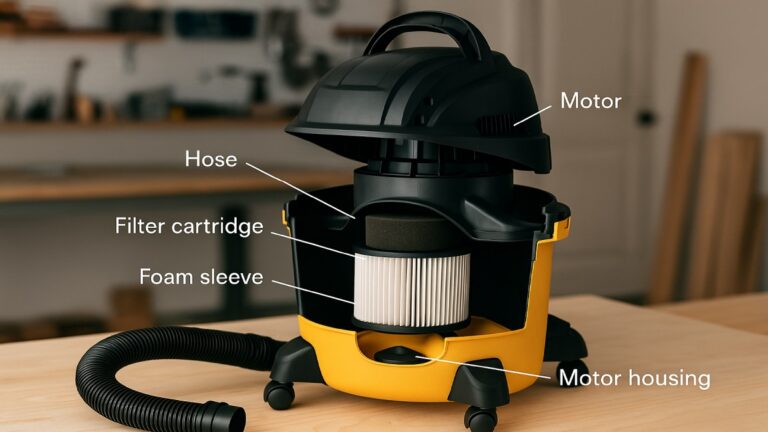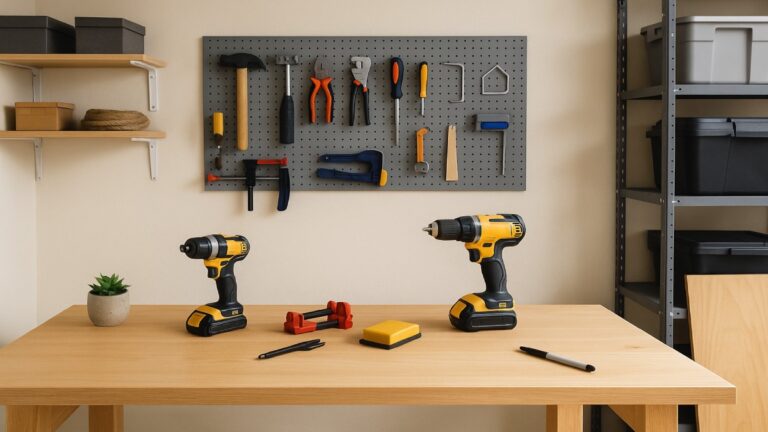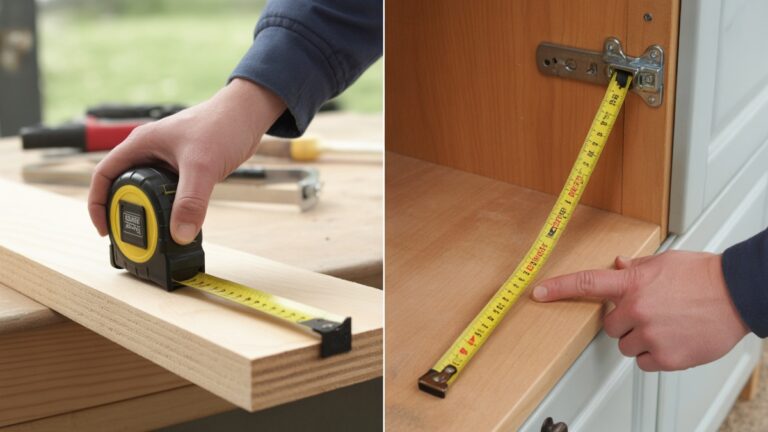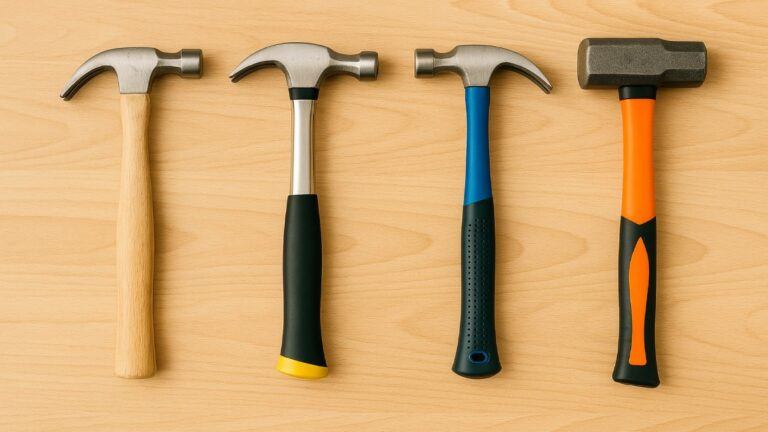Top 10 Power Tools Every Serious DIYer Should Buy in 2025
Upgrading your toolkit transforms how quickly and cleanly you handle renovations. The right power tools save time, cut frustration, and make finish work look professional. As battery platforms, brushless motors, and dust control evolve, certain tools deliver outsized value for home remodels, workshops, and weekend upgrades.
This guide ranks the top 10 power tools for serious home improvement. For each tool you’ll get a clear explanation of why it matters, one-line pros and cons, and model recommendations across three budget tiers. You’ll also get a shopping checklist and tiered buying strategy so you can build a toolbox that fits your projects and your wallet.

How we chose these top 10 tools
We ranked tools by practical impact: versatility, frequency of use, and the difference they make to outcome quality. Tools that enable multiple project types — driving, cutting, sanding, dust control — scored highest. Battery ecosystem compatibility, brushless motor tech, and dust-management features also influenced rankings because they improve runtime, longevity, and safety.
For each item we selected recommended models at three budget levels: Starter (value), Serious DIY (mid-tier), and Pro/Fleet (high-end). These recommendations reflect current 2024–2025 platform trends and buyer guidance from hands-on reviews and retailer combos.
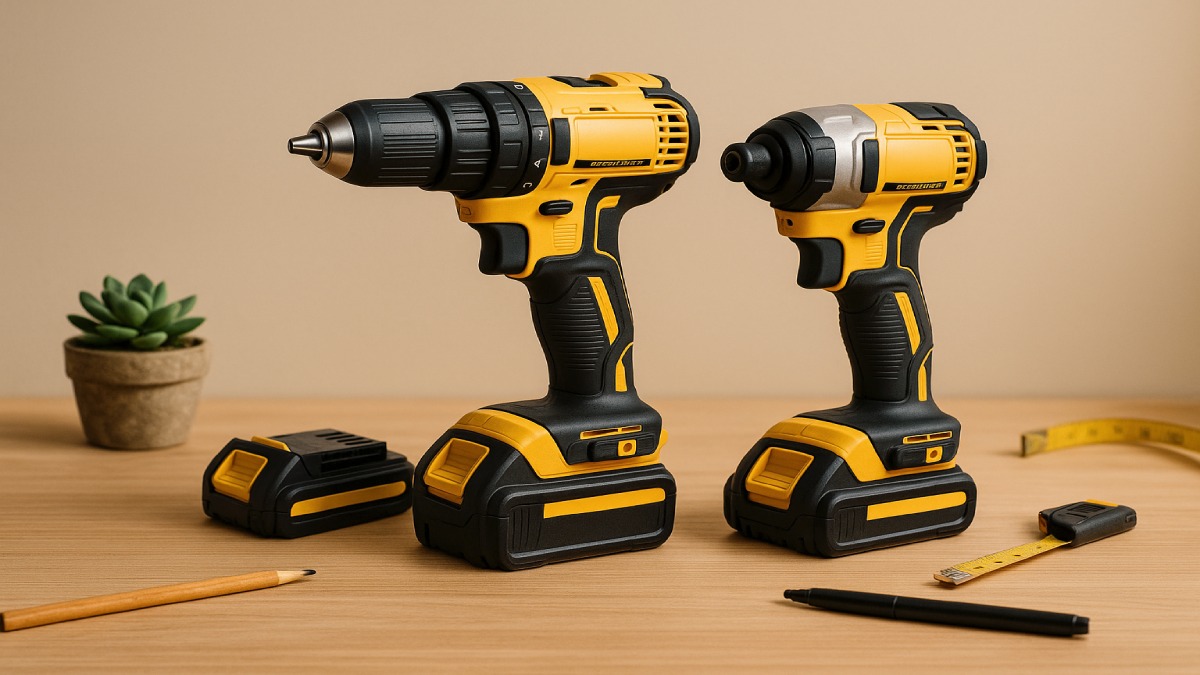
#1 — Cordless Drill + Impact Driver Combo (The Foundation)
Every serious DIYer should start here. A two-tool combo with two batteries covers drilling, driving, and most assembly tasks. Modern brushless motors deliver torque and runtime that rival corded models for most home jobs.
- Pro: Extremely versatile across projects — from hanging drywall to building decking.
- Con: Entry-level kits may use lower-capacity batteries that limit runtime on heavy jobs.
- Starter pick: Ryobi 18V ONE+ 2-tool combo — great platform value.
- Serious DIY pick: DeWalt 20V MAX brushless 2-tool kit — durable and powerful.
- Pro/Fleet pick: Milwaukee M18 Fuel 2-tool kit — best performance and ecosystem.
#2 — Impact Driver (High-Torque Workhorse)
While combos often include an impact driver, a standalone high-torque impact is worth its spot for deck building, lag bolts, and heavy fasteners. It reduces fatigue and speeds assembly.
- Pro: Compact yet powerful for driving large screws and bolts.
- Con: Not a substitute for an impact wrench on automotive lug nuts or heavy bolts.
- Starter pick: Craftsman V20 Impact Driver — dependable and affordable.
- Serious DIY pick: Makita 18V LXT brushless impact driver.
- Pro/Fleet pick: Milwaukee M18 Fuel impact driver.
#3 — Circular Saw & Track Saw (Ripping and Precision on the Go)
Circular saws remain ubiquitous for cutting plywood, framing lumber, and on-site trim. Track saws bring a new precision: splinter-free, straight cuts without a table saw. If you build cabinets or do finish carpentry, add a track saw and rails.
- Pro: Circular saws are portable; track saws deliver near-table-saw accuracy on site.
- Con: Track systems add cost and require rail management.
- Starter pick: Ryobi 18V circular saw — solid entry choice.
- Serious DIY pick: Makita 18V circular or Makita track saw for better cuts.
- Pro/Fleet pick: Festool TS/55 or DeWalt FlexVolt track saw — premium cut quality and rails.
#4 — Sliding Compound Miter Saw (Fast, Accurate Crosscuts)
A miter saw speeds up trim, molding, and framing cuts with repeatable accuracy. Sliding compound models expand cutting capacity for wider boards and crown molding setups.
- Pro: Fast, precise crosscuts and bevels; ideal for finish carpentry.
- Con: Heavy and needs a stable workstation or stand.
- Starter pick: Ryobi 10″ sliding miter saw.
- Serious DIY pick: DeWalt 12″ sliding compound miter saw.
- Pro/Fleet pick: Bosch or Milwaukee 12″ pro miter saw models.
#5 — Table Saw (Shop-Centric Precision)
The table saw is the heart of a serious wood shop. It delivers consistent rip cuts, enables joinery work, and lets you use jigs for repeatable accuracy. For many pros and advanced hobbyists, it’s irreplaceable.
- Pro: Best tool for long rip cuts, joinery, and high-precision work.
- Con: Large footprint and higher safety considerations.
- Starter pick: Skil or Ryobi jobsite table saw — good value for occasional users.
- Serious DIY pick: DeWalt 10″ jobsite table saw — balance of portability and power.
- Pro/Fleet pick: SawStop (safety & precision) or high-tier cabinet saws from Bosch/Makita.
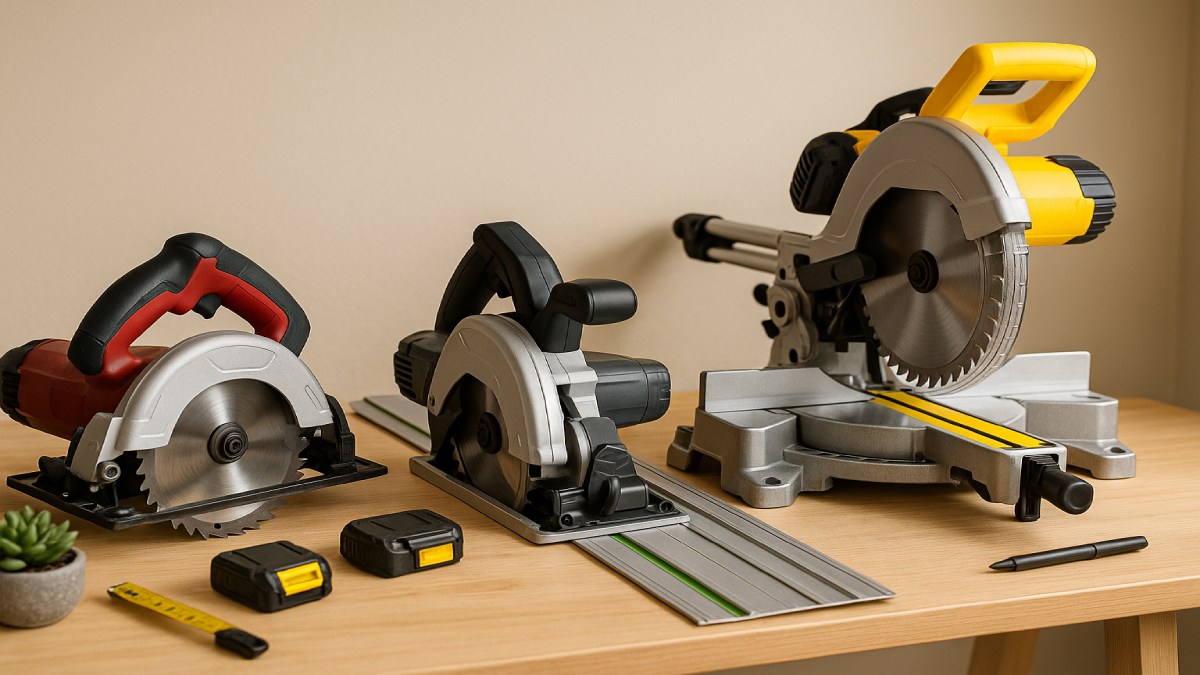
#6 — Reciprocating Saw (Demolition & Tough Cuts)
Recip saws excel at demolition, rough cuts, and cutting through nails, old framing, and plumbing. They’re an essential quick tool for teardown phases and awkward cuts where other saws won’t reach.
- Pro: Fast for demo and awkward cuts; versatile with blade types.
- Con: Rough cuts, not for finish work.
- Starter pick: Ryobi reciprocating saw.
- Serious DIY pick: DeWalt XR reciprocating saw.
- Pro/Fleet pick: Milwaukee M18 Fuel Sawzall.
#7 — Oscillating Multi-Tool (The Tight-Spot Specialist)
Few tools match the oscillating multi-tool for retrofit work: undercutting door casings, removing grout, sanding in tight corners, or making plunge cuts for plumbing and electrical. It’s a go-to tool for cleanup and finish detail.
- Pro: Extremely versatile for tricky, precise tasks.
- Con: Many attachments and a small work area require patience.
- Starter pick: Craftsman or Ryobi multi-tool.
- Serious DIY pick: Bosch or Fein multi-tool.
- Pro/Fleet pick: Fein Multimaster or Milwaukee multi-tool.
#8 — Random-Orbit Sander & Finishing Tools
Finish is where projects look professional. Random-orbit sanders remove material fast and leave minimal swirl, and paired with a dust extractor they let you sand quickly and cleanly for paint or stain prep.
- Pro: Speeds prep and leaves an even surface for finishing.
- Con: Dusty without extraction; consumable discs add recurring cost.
- Starter pick: Black+Decker or Skil orbital sander.
- Serious DIY pick: Bosch or Makita 18V random-orbit sander.
- Pro/Fleet pick: Festool or Mirka with dust extraction compatibility.
#9 — Shop Vacuum / Dust Extractor (Health & Finish Quality)
Dust management is no longer optional. Jobsite vacuums and dust extractors remove fine particles that harm health and ruin finishes. They also extend tool life and meet more stringent jobsite safety expectations.
- Pro: Cleaner work zones, better finish quality, and safer air.
- Con: Added cost and storage needs; hoses and adapters can be annoying.
- Starter pick: Shop-Vac 5–6 gallon wet/dry vac.
- Serious DIY pick: DeWalt or Bosch mid-range extractor with HEPA filter options.
- Pro/Fleet pick: Festool CT or a high-capacity dust extractor with auto-on feature.
#10 — Jigsaw or Router (Pick by Project Type)
These tools sit at the junction of versatility and specialty. Jigsaws handle curves, sink cutouts, and laminate cuts. Routers deliver joinery, edge profiling, and hinge mortises. Pick the one that aligns with your work.
- Pro (Jigsaw): Great for curves and cutouts; portable and easy to control.
- Con (Jigsaw): Less precise for straight long cuts than a track saw or table saw.
- Starter pick: Black+Decker or Ryobi jigsaw.
- Serious DIY pick: Bosch or Makita jigsaw; Bosch/Makita plunge router.
- Pro/Fleet pick: Festool jigsaw or professional plunge routers from Bosch/Makita.
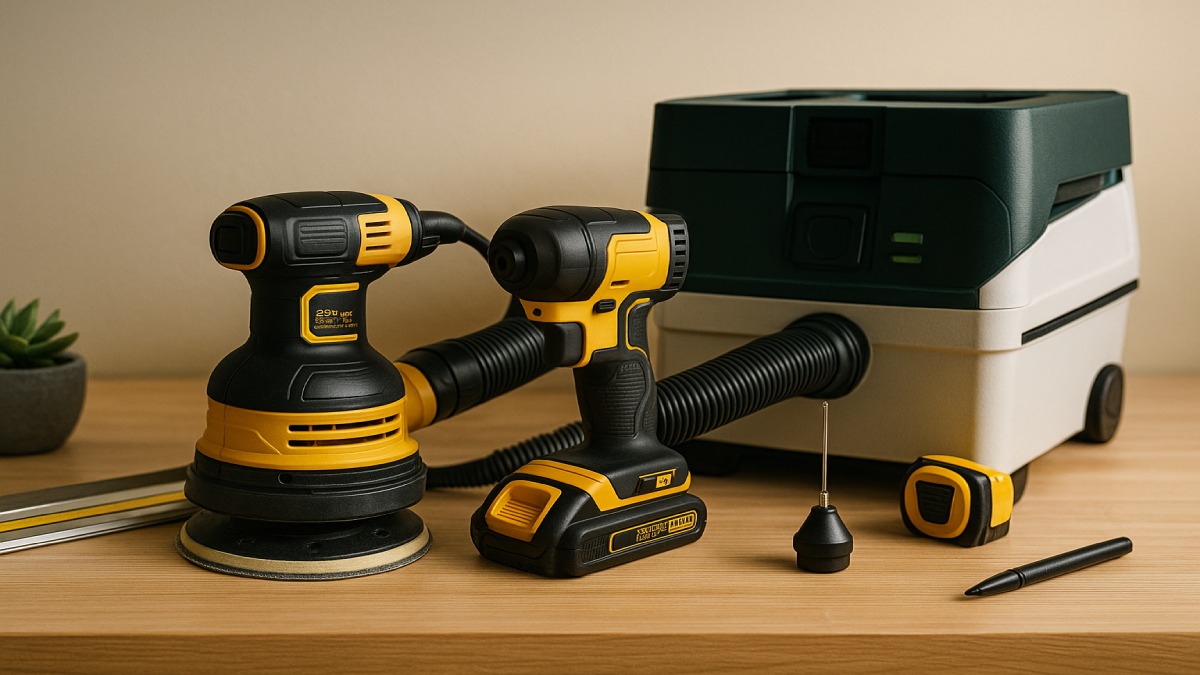
Shopping Checklist — Build Your Kit in Phases
Buy smart by stacking capability in waves. Start with core tools and add specialty machines as your projects demand them.
Phase 1 — Immediate Essentials (Start Here)
- Drill + impact driver combo (2 batteries + charger)
- Circular saw (or track saw if you do finish work)
- Basic safety gear: glasses, hearing, respirator for dust work
- Tape measure, carpenter pencil, speed square, clamps (4–8)
Phase 2 — Add Capability
- Miter saw for trim work
- Reciprocating saw for demolition
- Oscillating multi-tool for retrofit tasks
- Random-orbit sander and shop vacuum
Phase 3 — Shop & Precision Upgrades
- Table saw or track saw system
- Router (plunge and fixed) and bit set
- Dedicated workbench and strong lighting
Budget Tiers — Where to Spend and Where to Save
Match tools to your use-case and budget. You’ll spend more upfront for pro-grade durability, but you get long-term reliability and platform benefits.
Starter Tier ($300–$700)
Best for occasional projects and new homeowners. Focus on a drill/impact combo, a basic circular saw, and finishing tools. Buy a reliable platform if you plan to grow later.
Serious DIY Tier ($1,200–$3,000)
Great for frequent renovators: invest in durable mid-range brands, a miter saw, a good circular or track saw, sander, and a dust extractor. Add extra batteries and chargers for uninterrupted work.
Pro / Fleet Tier ($4,000+)
For contractors and heavy users: buy pro-grade batteries and multiple tool bodies across a single platform. Invest in SawStop or equivalent table saw, robust miter saw, track saw system, and high-capacity dust extraction. The ROI comes via reduced downtime and longer tool life.
Buying Tips & Platform Strategy
Two long-term decisions affect cost and convenience more than any single tool: which battery ecosystem you commit to, and whether you choose brushless motors. Stick to one battery family to reuse packs and chargers. Prioritize brushless-equipped tools for efficiency and lifespan. Finally, add dust control early — it improves finish and health on every job.
FAQs — Quick Answers for Common Questions
How many power tools does a serious DIYer need?
Start with the core five: drill/impact combo, circular or track saw, miter saw, table saw (or access to one), and a sander. Add specialized tools like a jigsaw, reciprocating saw, or router as your projects require.
Are cordless tools better than corded tools?
Cordless tools now handle most handheld tasks with ease thanks to battery advances, but corded machines still rule where continuous high power matters, such as full-size table saws and some routers.
What battery platform should I choose?
Pick a platform that matches your budget and brand preference; Milwaukee, DeWalt, Makita, and Bosch lead pro platforms. Ryobi offers broad value-platform coverage for casual users. Commit early to avoid mixing incompatible batteries.
Which tool should I upgrade first?
Upgrade the drill/impact combo first for immediate versatility, then add saws based on whether you do framing, trim, or cabinet work.
Final takeaway — Build for the work you do
Buying the right power tools transforms projects. Start with essentials, commit to a battery ecosystem, and add precision and dust-control tools as your skills and projects expand. With the right tools, even ambitious renovations feel manageable and the final results look professional.

